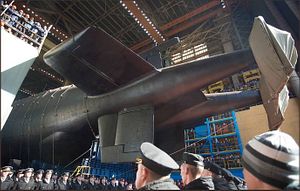Russia has launched the Project 09852 Special Mission Submarine KC-139 Belgorod at the Sevmash Shipyard, located in Severodvinsk in northern Russia, on April 23. It is reportedly the first nuclear-powered submarine capable of carrying the nuclear-capable underwater drone “Poseidon,” alternatively referred to as an unmanned underwater vehicle (UUV), autonomous underwater vehicle (AUV), or simply an intercontinental-range, nuclear autonomous torpedo.
The Belgorod is slated to enter service with the Russian Navy in 2020 following nuclear reactor and dockside trials. The submarine, based on the 949A Oscar II-class nuclear-powered guided missile submarine (SSGN), while crewed by the Russian Navy, will be operated by the Main Directorate Deep Sea Research (GUGI) organization. The submarine, according to the website Covert Shores, will carry a deep diving midget submarine for covert special missions. It is expected to be deployed under the Arctic and used for the covert installation of a Russian underwater sonar network.
During the April 23 launch ceremony, Vice-Admiral Alexei Burilichev, Head of the Main Directorate of Deep-Sea Research of the Russian Ministry Defense (MoD), specifically singled out the Arctic as a future area of operations for the sub: “With the advent of this ship in the fleet, the Russian Federation will increase its ability to study the oceans, including the Arctic,” he was quoted as saying by TASS news agency.
The submarine was laid down at the Sevmash Shipyard in July 1992 but its construction was suspended in 1997. Work on the unfinished 949A Oscar II-class SSGN began again in 2012 following a redesign of the sub undertaken by the Rubin Central Design Bureau in St. Petersburg as a special purpose submarine. With a reported lengths of 184 meters, the Belgorod is set to become the Russian Navy’s largest submarine by its length. (The sub has a reported displacement of around 15,000 tonnes when surfaced.)
There is no official confirmation that the new sub will carry the Poseidon UUV, also known under Ocean Multipurpose System Status-6 or “Kanyon” by the U.S. intelligence community. As I reportedly previously, the Russian Navy is expected to receive up to 30 Poseidon UUV with the first batch slated for delivery in the late 2020s. It remains unclear the UUV serves only as a nuclear-warhead delivery platform or could be used for other purposes including intelligence, surveillance, and reconnaissance (ISR) missions.
According to a Russian defense industry source, the Project 09852 submarine will be able carry up to six Poseidon UUVs, although as mentioned previously, some sources cited eight. “Two Poseidon-carrying submarines are expected to enter service with the Northern Fleet and the other two will join the Pacific Fleet,” a Russian defense industry source told TASS news agency in January. “Each of the submarines will carry a maximum of eight drones and, therefore, the total number of Poseidons on combat duty may reach 32 vehicles.”
The second Poseidon-carrying sub will reportedly be the Project 09851 submarine Khabarovsk, purportedly a downsized variant of the Borei-class of nuclear-powered ballistic missile submarines. The sub is slated to be launched in the spring of 2020 and handed over to the Russian Navy in 2022, according to another source.

































